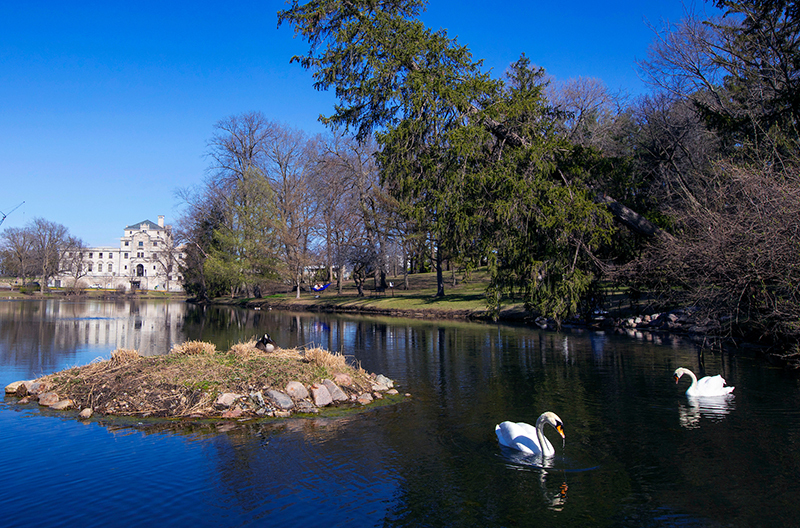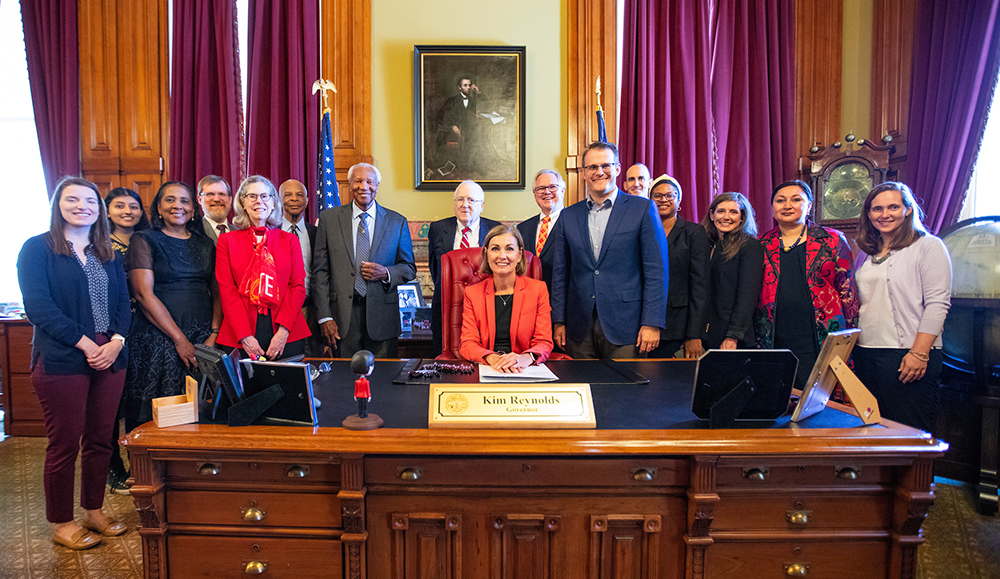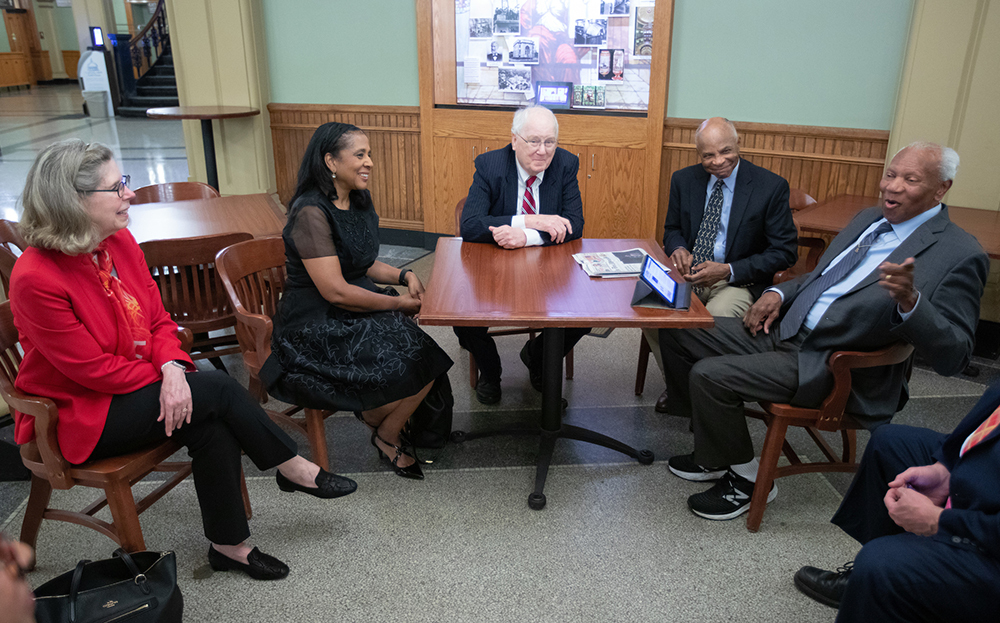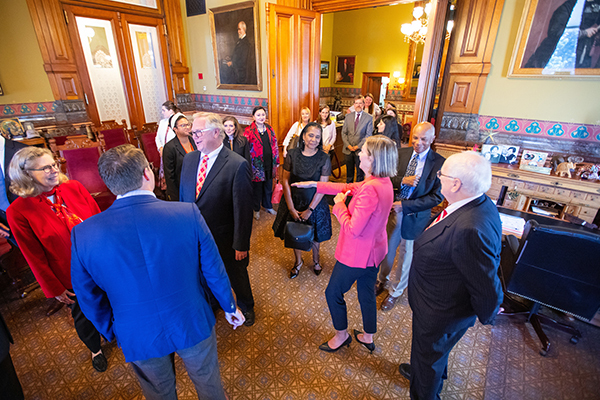Installation of bridge span requires lane, road closures

Aerial view of the East Gateway Bridge and Jack Trice Stadium. Photo courtesy of ISU athletics communications.
Planned closures (weather dependent)
One lane each direction: 7 a.m.-7 p.m. Monday, June 27-Friday, July 22
Road: 7 p.m.-7 a.m. June 28-July 1
Construction crews are ready to install the gateway bridge span over University Boulevard, which will require traffic lane restrictions and overnight road closures. The $10 million bridge project will provide a safe pedestrian route between Jack Trice Stadium and game-day parking areas east of the stadium.
Starting Monday, June 27, for approximately four weeks, University Boulevard traffic will be restricted to one lane in each direction.
The road will be closed overnight Tuesday through Friday nights, June 28-July 1, with a designated detour in place. Overnight traffic will be routed around the west side of the stadium using South Fourth Street, Beach Avenue and Mortensen Road. Motorists traveling north on University Boulevard will be able to access South 16th Street during the overnight closures.
The athletics department is paying for the quarter-mile long, elevated walkway with donor funds. Facilities planning and management expects it will be completed in late July and in use for Iowa State's first home football game on Sept. 3. The project also includes a walkway outside the northeast corner of the stadium to connect the north plaza area and promote year-round use of the bridge, and fencing along the west side of University Boulevard.

A Henkel Construction team places concrete sections of a walkway outside the Jack Trice Stadium that connects the pedestrian bridge to the plaza north of the stadium. Photos by Christopher Gannon.

The northeast walkway as it approaches the pedestrian bridge outside the east concourse of Jack Trice Stadium.
New ISU website and employee portal launch next week
Iowa State's homepage will have a dramatically different look -- and focus -- when the redesigned university website launches early next week.
Student recruitment is priority one for the university's new site, moving nearly the entire admissions website to www.iastate.edu. The transition is timely, as admissions enters its next recruitment and application cycle on July 1.
The new sites -- numbering more than 100 pages -- are the result of a year's worth of planning, research and development, and are scheduled to launch Monday evening, June 27. The project team includes staff from admissions, IT services and strategic relations and communications, and consultants with idfive, a Baltimore-based agency.
How to get to faculty-staff resources
Two new portal-style pages, for faculty and staff and for current students, have been designed to make it easy and convenient to access what they need for daily online work or learning. The portal page design is simple and flexible to address changing needs and priorities.
The portals provide quick access to the most-used information and resources for everyday working and learning, as determined by input from nearly 1,000 responses to an April survey of all employees, focus group interviews and a deep dive into web analytics of current sites.
To find the portal pages for the first time, direct links are available in the "Info for" dropdown menu at the top of the new homepage, next to the "Sign ons" link to the Okta login page.
One recommendation for employees is to make the faculty/staff portal page the default page each time your web browser launches. Go to your web browser "preferences" and in the startup options, set the faculty/staff portal page to automatically launch when you work online. Another option is to create a bookmark for the page, also within your browser.
Free theme package for redesigns
The new theme is being packaged for campuswide use in multiple formats and will be available this fall to all colleges, departments and units at no cost. Online training modules and a style guide outlining best practices will be included with the theme package, and the project team will offer guidance and consultation.
As part of the web redesign project, an "ecosystem" of components was created for use in custom designing college, department, unit and individual profile websites. The goal is to provide a consistent user experience with easy transitions from site to site and the same look and feel across all Iowa State sites.
The previous website theme, introduced five years ago, will sunset. Current users will be supported, but Iowa State units planning website updates or redesigns are expected to adopt the new look and theme, especially for student-serving or student-centric sites.
Admissions' "adventure" theme for student recruitment also is ending. After extensive research, admissions will introduce a new recruitment campaign during the fall semester.
Related story
- Employee survey will help prioritize central ISU portal, April 14, 2022
Regents propose 4.25% tuition increase for this fall
Meeting virtually June 20, the state Board of Regents announced a proposed 4.25% tuition increase for undergraduate and graduate students at Iowa State this fall. Excluding differential tuitions, that translates to a:
- $354 annual tuition increase for resident undergraduates, to $8,678
- $1,026 increase for nonresident undergraduates, to $25,162
- $432 increase for resident graduate students, to $10,572
- $1,092 increase for nonresident graduates, to $26,776
As proposed, tuition for professional veterinary medicine students would go up 5% ($1,258) for residents and 3.5% ($1,938) for nonresidents.
The board is expected to approve 2022-23 tuition and mandatory student fee rates at its July 27 meeting.
Differential rates aligned in two groups
With a final differential tuition increase this fall for sophomore students in engineering, ag systems technology and industrial technology majors, Iowa State would conclude a multi-year effort to simplify dozens of differential tuition rates into two categories. For resident undergraduates this fall, the two differentials are $1,794 and $2,928.
The regents approved the first differential tuition requests at Iowa State for the 2006-07 school year to cover higher costs of instruction. More requests followed in subsequent years. In June 2018, Iowa State proposed its two-tier differential tuition structure. With the exception of sophomores in engineering, ag systems technology and industrial technology, that alignment was completed in the 2021-22 academic year.
Iowa State is proposing to remove the tuition differential ($2,486) for its master of real estate development to help grow enrollment in the program. The change is based on internal market research and feedback from current and prospective students.
Mandatory fee increases
As proposed, the mandatory student fee package would increase $145 (11%), to $1,455, primarily to support the increased costs of providing services to students. The increase is derived from increases of $70 to the technology fee, $24 to the health fee, $21 to the student services fee (for CyRide operations), and $30 to the recreation fee.
Student leader comments
As part of the annual tuition-setting discussion, the regents receive comments from student leaders on the three university campuses. Student government president Jacob Ludwig and Rachel Sorensen, incoming president of ISU's graduate and professional student senate, agreed the 2022 Iowa Legislature left the regents "in a tough position," as Sorensen termed it.
"Less-than-desirable appropriations from the state make it impossible to maintain the current rate of tuition and the high level of academic quality at our institutions," Ludwig said. "Though a tuition raise is regrettable, I know the board does not make this decision lightly or with malice."
Noting that tuition has climbed steadily since 2000, "support from the state has pretty much stagnated. Acquiring additional funds has been an uphill battle that is harder to win with each passing year," he said.
He pledged Iowa State student support during the next legislative cycle to make the case for better state funding of public higher education.
Regents' tuition guardrails
In November 2018, with the goal of making education costs more predictable for students and families, the board approved a five-year plan that ties the size of tuition increases for resident undergraduates directly to state funding increases. The "guardrails," as board president Michael Richards termed them, apply to Iowa State and the University of Iowa.
- If the Iowa Legislature fully funds the schools' appropriation requests, the base resident undergraduate tuition would increase 3 percent in the fall.
- If state funding remains unchanged for the next fiscal year, resident undergraduate tuition would increase 3 percent plus the projected HEPI (Higher Education Price Index). According to economists in Iowa's Tippie College of Business, the HEPI projected midpoint for FY23 is 3.7%.
- If the Legislature partially funds the universities' funding requests (this year's scenario), resident undergraduate tuition would be set somewhere in between. According to the agenda document, the proposed increase for this fall could have been as high as 5.6%.
Advocacy from experience

Debbie Roberts' interest in advocating for better understanding of limb loss and limb difference prompted her to pursue a state proclamation through the governor's office. Photo by Christopher Gannon.
When Gov. Kim Reynolds signed a proclamation April 26 making April "Limb Loss and Limb Difference Awareness Month" in Iowa, the chief proponent behind that special order was payroll coordinator Debbie Roberts. Following six years as Mary Greeley Medical Center's sole payroll coordinator, Roberts joined Iowa State's payroll team last fall.
She self identifies as a congenital amputee, born in 1965 with a left arm that ends just below her elbow. She grew up in the small community of Paton, attending Paton Churdan schools. When she was 14 and against her wishes, a surgeon removed five tiny fingers "the size of Rice Krispies" on her left arm.
According to the Centers for Disease Control and Prevention, about 1,900 Americans each year are like Roberts, born with a limb either missing or reduced in size. And approximately 185,000 Americans each year lose a limb -- or part of a limb -- primarily due to blood circulatory problems, accidents or cancer. Combined, that's more than 2 million Americans living with a limb loss or limb difference.
Building awareness
The April proclamation, Roberts said, really is about awareness.
"I think people who aren't missing a limb just need information so they're more comfortable. They don't have to be scared and they don't need to stare," she said. "My own preference is that people ask me questions. I let them touch my arm or mess with my prosthesis."
Her interest in advocacy emerged over the last five years as she joined organizations full of people like her: the Lucky Fin Project (named by a young mom for Nemo in the 2003 Disney movie), Iowa chapter of the Amputee Coalition and the annual EmpowerFest -- support and practical skills for amputees, including advocacy training she completed.
"As a kid, I never thought my situation was horrible. But in my small town, I just didn't think anyone else was born like me," Roberts said. "The only thing that came close was farmers who lost limbs in accidents.
"So, it's quite an emotional experience to be in a room with 700 people all born without their arms, to have so many adults you can relate to and so many kids you can help," she said.
All those new relationships inspired her to do more.
'There's no reason you can't'
But even before the new friendships, Roberts credits her family -- parents, older sister, younger brother -- with her can-do spirit.
"I never felt like I couldn't do something. They told me, 'You're fine. Go do it. There's no reason you can't,'" she recalled.
When her kindergarten teacher informed her she'd be excused from phys ed class because she didn't have two hands, her parents were at the school the next morning to correct that decision.
For much of her life, she despised the words "handicap" and "disability." Now, she said she recognizes that a limb difference is a disability.
"My disability is that I had to learn how to do all these things a different way than other people do -- with one hand instead of two."
And she developed her way to do lots of things: Tie shoestrings, stay in a swing, swim, dive, certify as a pool lifeguard, play competitive volleyball and basketball, care for animals, cheerlead, bowl, shovel snow, drive a car, waitress, change diapers, put socks on a toddler, cut hair.
Her prosthetic arm popped off anytime she tried to play on the monkey bars in elementary school, she concedes she's not great at braiding hair and she's been advised she'd golf better with a left-handed club in her front right hand. But there's very little she won't try.
Growing up, her dad insisted she wear a prosthetic arm, and she did through high school. When the choice was hers, she lived and worked without a prosthesis for nearly 35 years. Five years ago, she met Miss Iowa 2013, Nicole Kelly, also a congenital amputee, who wore a device with a bionic hand "that was very functional." Roberts was interested, in part due to the wear on her right shoulder from decades of doing nearly everything with one arm.
Earlier this month, she received approval for her third bionic arm. The sophisticated devices cost more than $230,000, but warranties of just one or two years give the prostheses impossibly short lives, she said. However, repair costs outside of a warranty are prohibitive. Using a smartphone app, she calibrates the device for up to 40 different functions, for example gripping a key. Her brain trains arm muscles to stimulate electrodes in the upper shell of the device.
Up next
Roberts said she finds satisfaction in helping others, whether it's assuring parents of a newborn child with a limb difference, testing products for prosthetic companies or making how-to videos to share online.
With limb difference friends from Oregon and Texas, she runs a Facebook site, the Up Nub Club, on which they post videos and links to helpful stories for people missing a limb. The trio's long-term wish is to develop a school program for children about limb loss and tour with it.
Roberts identified another need, a people-finder website or smartphone app to help amputees who live in proximity connect with each other -- and not have to rely on state or national conferences to meet. It would take funding to develop, but she has thought through the concept and found a website developer who would help.
"I never expected I'd get this involved, but I love it. If I could focus on this full time, I would. It keeps me learning."
Small-loan program ensures employees a borrowing option
Unexpected financial emergencies don't have to be massive to strain a household budget, but the impact is worse without access to credit. Surprise bills can lead people with limited borrowing options to costly alternatives like payday loans that may exacerbate the problem.
Greater Iowa Credit Union is offering a new small-dollar loan program for Iowa State employees, as part of an ISU Extension and Outreach pilot project to improve financial wellness. The program will ensure university employees have a choice when facing short-term financial difficulty.
The Wellness at Work Small Dollar Loan program, available through the credit union, offers ISU faculty, staff and post-docs a personal loan at an annual interest rate of 9.99%, no matter their credit score. Loans can be from $500 to $2,500, for terms of either 12 or 24 months. There is no origination fee or other added costs. Loan funds usually are available within 24 hours and often on the same business day as the application. Funds can be deposited in the borrower's account, or a check can be made out to a specific business.
"Our hope with the Wellness at Work Small Dollar Loan program is to make a difference for any Iowa State University employee who may need help getting through a financial situation they are facing, especially for someone who may have limited access to credit," said Suzanne Bartholomae, assistant professor of human development and family studies and human sciences state extension specialist.
Borrowers must apply in-person at one of the credit union's nine branches, including three in Ames. Though the credit score doesn't affect the loan decision, the confidential application includes a credit check to verify identity, residence and bankruptcy status. Borrowers must be Greater Iowa Credit Union members, which requires an initial deposit of at least $5.
Through its Financial Wellness at Work pilot project, ISU Extension and Outreach provides ISU employees with financial education and resources, such as workshops and one-on-one consultations. It is made possible, in part, by a grant from the FINRA Investor Education Foundation through a partnership with United Way Worldwide.
Greater Iowa Credit Union is an Ames-based, not-for-profit financial cooperative offering a full range of financial services. It has prior experience offering an employee-only small-dollar loan program and a historic connection to campus, being founded in 1932 by workers from the university's buildings and grounds crew.
"We are excited to continue our support of Iowa State University faculty and staff," said CEO Scott Zahnle. "People are at the heart of everything we do, and we are thrilled to further our mission of making financial stability attainable for everyone."
Welcome

Steve Kohtz is the the recycling and special events coordinator. Photo by Christopher Gannon.
Steve Kohtz (pronounced "coats") started June 1 as the recycling and special events coordinator, a position in facilities planning and management that leads the university's waste reduction efforts.
This is Kohtz's second stint working in an environmentally minded position at Iowa State, having served as the sustainability coordinator for three years as a part-time graduate assistant starting in 2015 and then for one year on a full-time basis in 2018-19. In that role, he managed student interns and helped oversee various aspects of the Live Green campaign.
He also taught ISU undergraduate graphic design courses from 2015 through 2018. From 2002 to 2011, he was the music ministry program and outreach director at Gloria Dei Lutheran Church.
Kohtz earned bachelor's degrees in graphic design from Grand View University, Des Moines, and in vocal music performance from Concordia University, Seward, Nebraska.
Contact Kohtz at 294-4963 or by email at sakohtz@iastate.edu.
Pell grants are golden
June 23 marks 50 years since President Richard Nixon signed a set of amendments to the Higher Education Act of 1965, one of which created the federal Basic Educational Opportunity Grant, known today as the Pell grant (renamed in 1980 for its sponsor, Rhode Island Sen. Claiborne Pell). Pell reasoned that a lack of financial wealth shouldn't keep a capable, talented, driven person from attending college.
In its 50-year history, more than 80 million low- and moderate-income students have received Pell grants.
During the 2021-22 academic year at Iowa State, 5,188 or one in five undergraduates -- 74% of them Iowa residents -- received a Pell grant, totaling more than $23.5 million in student aid. In the last 10 academic years, 28,766 Iowa State students received more than $255 million in Pell grant aid.
Director of student financial aid Roberta Johnson, who began her undergraduate years at Luther College in Decorah before completing her degree at Iowa State, is among the 80 million students who benefitted from the program.
"As one of five siblings in a family that sometimes struggled to make ends meet, the Basic Educational Opportunity Grant was foundational in helping me achieve my dream of a college education," Johnson said.
"It has been gratifying to spend the last 40 years administering the program that made such a huge difference in my educational journey, assisting students seeking the same goal I had decades ago."
Emily Olson, assistant director of student services for the College of Liberal Arts and Sciences, said her Pell grant greatly reduced her student loan debt when she graduated from St. Olaf College, Northfield, Minnesota.
"As a first-generation, low-income student, I didn't know how I would pay for college, only that I was expected to go," she said. "The Pell grant I received helped alleviate some of the financial burden of college."
The Association of Public and Land-grant Universities, of which Iowa State is a member, is a leader in the #DoublePell alliance that's working to persuade Congress to double the size of the maximum Pell grant ($6,895 for the coming year) to help more students with a demonstrated financial need earn a college degree.
Richmond promoted to lead EHS department

Paul Richmond
Paul Richmond, director of environmental health and safety (EHS), will be promoted to assistant vice president for environmental health and safety, the top leadership role in the unit responsible for injury prevention, environmental protection, safety and preparedness.
The appointment, effective July 1, will follow the June 30 retirement of David Inyang, the current assistant vice president of EHS.
With Inyang's departure and the July 5 retirement of Stephen Simpson, director of emergency management outreach, it was important to build on the department's strong foundation, and Richmond was a natural choice, said university counsel Michael Norton, who oversees EHS.
"Paul is a tremendous leader and a recognized expert in environmental health and safety. He has a deep knowledge of the university and is respected and trusted by university leadership, the EHS organization and the greater campus community that he serves. I look forward to working with him to continue to build upon the expertise and service that is the hallmark of the department," Norton said.

David Inyang
Richmond has been with EHS since 1993 and earned a bachelor's degree in geology from the University of Missouri and a master of public affairs from Indiana University.
EHS is celebrating its 50th anniversary this year, and Norton noted that Inyang has been with the department for 32 of those years, providing leadership that has helped establish the unit's excellence.
"Along with Steve Simpson and Paul Richmond, David has built a foundation of safety, emergency management and service that has been critical to advancing the mission of the university," he said.
Iowa State swan has died

University photographer Chris Gannon captured this image of Lancelot and Elaine on Lake LaVerne in spring 2020. File photo.
One of campus' iconic swans was found deceased Monday of this week. The set of mute swans had made its home on Lake LaVerne since 2003, so the death is believed to be from natural causes, said campus planner Chris Strawhacker, facilities planning and management (FPM).
He said the lone swan will remain on the lake while an FPM team investigates best options for introducing one or two swans to the lake and the timing of any changes. The group is consulting with others on campus, including wildlife specialists.
By design, both swans were female, so it's difficult to say which bird died, Lancelot or Elaine.
Lancelot and Elaine through the years
Iowa State's first pair of swans, also mute swans, was introduced onto Lake LaVerne in 1935. Their names, Lancelot and Elaine, reference lovers in the narrative poem "Idylls of the King" and emerged from a naming contest that spring. Regardless of the era, the swans have kept those names.
In 1995, the state Department of Natural Resources asked the university to try trumpeter swans as part of its efforts to reintroduce the once-native bird to Iowa.
Iowa State discontinued its use of trumpeter swans four years later because of their wandering and aggressive nature, including indifference to vehicle traffic. Mute swans, which tend to spend more time on the water, returned. Nonbreeding mute pairs are used to prevent reproduction of the non-native species. The female duo arrived in 2003 when the 1999 male pair developed aggressive tendencies as they matured.
Even with relaxed rules, help is useful for loan forgiveness program
The Public Service Loan Forgiveness (PSLF) program is getting easier to access under temporary rule changes enacted last fall. Some guidance still helps, though.
Through early May, about 127,000 applicants have successfully used the limited-time waiver of some of the strict regulations that have hampered PSLF, a federal program designed to forgive student loan debt for full-time workers after 10 years in a government job. That's a big spike that includes 1,620 Iowa borrowers who have eliminated a combined $73.3 million in debt, according to U.S. Department of Education data. In the four years borrowers could apply before the waiver, fewer than 20,000 were approved due to a rejection rate of about 98%.
But even under the waiver rules, about half of PSLF applications have been rejected, said Lindsay Clark, director of external affairs for Savi, a TIAA-run student loan repayment assistance service offered to Iowa State faculty and staff. Processing times also have been slow, with backlogs often running longer than three months.
"Good policy is one thing, but actual implementation is another," Clark said in a recent online briefing.
Most of the rejected applications should not have been denied and were later accepted, she said. That's what makes Savi a valuable resource even with the PSLF waiver, said Ed Holland, director of benefits and WorkLife for university human resources.
"Going it alone is not in an employee's best interest, and Savi is a great tool to help navigate the process," Holland said.
What ISU employees are saving
Savi, available to benefits-eligible ISU employees since June 2021, sorts through more than 150 state and federal assistance options to propose personalized repayment and forgiveness plans based on income, family size, debt amount and employment history.
At the free "DIY" level, employees receive links to the forms needed to apply for the recommended programs and take it from there themselves. At the "essential services" level, which costs $60 per year, Savi acts as a concierge, processing all the application forms, employer verifications and annual recertifications. Essential services clients also receive ongoing monitoring and one-on-one customer support.
In its first year, 204 ISU employees holding a combined $9.4 million in student loan debt registered with Savi, including 54 premium users. ISU participants lowered their projected monthly student loan payment by $161, on average. (As part of the response to COVID-19, repayment of most federal student loans has been paused since March 2020. The pause is set to expire Aug. 31, though it has been extended six times.)
Based on completed plans created by Savi, ISU employees using the service will see a projected average of $25,506 in loan forgiveness, a total of nearly $2.5 million.
Employees can sign up for Savi online any time and don't need to be a TIAA client. For a commitment-free assessment, employees need to supply their social security number, the first page of their most recent tax return and login information for any loan servicing companies they are using. For more information, consider joining one of Savi's twice-monthly online student loan forgiveness workshops. Upcoming workshops are June 15 at 11 a.m. and June 29 at 1 p.m.
What's in the waiver?
PSLF is one of the most common forgiveness options Savi recommends. The PSLF temporary waiver for some of the program's intricate rules runs through Oct. 31 and is allowed under emergency rules due to the pandemic. It could eliminate up to $4 billion in student loan debt nationwide, according to Department of Education estimates.
For applications filed by Oct. 31, past periods of repayment count toward the required 120 months even if the loan type or repayment plan would usually run afoul of PSLF rules. For example:
- PSLF applicants with loans through the Federal Family Education Loan (FFEL) and Federal Perkins Loan programs typically receive credit only for payments made after consolidating into a Direct Consolidation Loan. The waiver allows pre-consolidation payments toward FFEL and Perkins loans to count for PSLF. Applicants are still required to consolidate into a Direct Loan before applying for forgiveness.
- Every month in a repayment plan counts toward the 120-month requirement, even if the borrower paid late, paid less than the amount due or didn't make a payment that month.
- The temporary change to the payment rules means that borrowers whose federal student loan payments have been suspended during the pandemic can receive PSLF credit for repayment during those months -- which could account for about one-quarter of the 120 required months, if payments begin again in September as currently planned.
- Forbearance periods of 12 or more consecutive months or 36 or more cumulative months will count toward the 120-month mark, as will some deferment periods. In-school deferments and months when a loan has been in default will not count.
The waiver doesn’t change what sort of employment qualifies a borrower for the forgiveness program. Applicants still must have worked at least 30 hours per week for the government or a nonprofit that is tax-exempt under section 501(c)(3) of the Internal Revenue Code, which includes most private schools.
However, there is one change for applications submitted during the waiver period. Applicants will be eligible even if they're not working for a qualified employer at the time of the application or when their debt is eventually forgiven. Program rules usually require applicants to be employed at a qualifying job both at the time they apply and when forgiveness is granted.
For more details on the waiver rules, see the PSLF waiver website.
Feb. 1 will be George Washington Carver Day in Iowa

Standing behind Gov. Kim Reynolds (seated) for the June 16 bill signing are (l-r) Natalie Bidner and Neha Kashyap, World Food Prize Foundation; Angela Franklin, Des Moines University; John Woell, Simpson College; Wendy Wintersteen, Iowa State University; Thomas Phillips, retired from Pioneer; Simon Estes, Iowa State University; Kenneth Quinn, World Food Prize Foundation; Charles Sukup, Sukup Manufacturing; Lt. Gov. Adam Gregg, State of Iowa; Joe Murphy, Iowa Business Council; Brooke Axiotis, Iowa Board of Education; Andrea Woodard, Greater Des Moines Partnership; Mashal Husain, World Food Prize Foundation; and Catherine Swoboda, horticulture, Iowa State University, and George Washington Carver Foundation. Photo by Christopher Gannon.
On June 16, Gov. Kim Reynolds signed Senate File 2380 into law, which designates Feb. 1 each year (the beginning of Black History Month) as George Washington Carver Day in Iowa, and encourages government offices, civic organizations, schools, colleges and universities to recognize the agricultural, scientific and global humanitarian accomplishments of Carver. (The designation did not create a state holiday.)
Missouri native Carver, who began his college work at Simpson College, Indianola, received bachelor's (1894) and master's (1896) degrees in agriculture from Iowa Agricultural College (since 1959 Iowa State University). Carver was Iowa State's first Black student and faculty member before leaving for a lifelong career at Tuskegee Institute, Alabama, developing hundreds of food products from plants such as peanuts, sweet potatoes and about a dozen others native to the southern United States.
Ambassador Kenneth Quinn, president emeritus of the World Food Prize Foundation, and Simon Estes, internationally renowned opera star and faculty member at Iowa State and the Des Moines Area Community College, were the driving force behind the designation. Quinn and Estes recounted the effort, with a nod to support from President Wendy Wintersteen, in a June 19 essay in the Des Moines Register.

Adjunct professor of music Simon Estes, shares a story as proponents of George Washington Carver Day gather in the ground level of the capitol June 16 prior to a bill signing with Gov. Kim Reynolds. Seated (l-r) are Iowa State President Wendy Wintersteen, Des Moines University president Angela Franklin, World Food Prize Foundation president emeritus Kenneth Quinn, Pioneer retired community investment director Thomas Phillips and Estes. Photo by Christopher Gannon.
Large groups visiting campus this summer
Most organizations have resumed in-person event schedules, meaning students, faculty and staff will again share campus this summer with thousands of visitors coming for camps, conferences, competitions and other gatherings.
Here's a list of summer events in ISU facilities that are expected to draw 100 or more visitors. Email inside@iastate.edu to suggest any additions we've missed.
|
Event |
Date |
Venues |
Attendance |
| Freshman orientation | June 1-30 | Various* | 15,000 |
|
June 26-29 |
Beyer and State Gym* | 150 | |
| Iowa 4-H Youth Conference | June 28-30 | Various* | 500 |
| Iowa Swine Day | June 30 | Scheman Building | 600 |
| BravO! National Dance Competition | July 5-10 | Stephens Auditorium | 1,500 |
| National Dance Association camp | July 8-12 | Beyer and State Gym* | 160 |
| State Fire School | July 22-24 | Iowa State Center | 800 |
|
July 22-24, 27-31 |
Various |
2,000 first weekend, 18,000 second weekend |
|
| Aug. 8-11 |
Scheman Building |
350 |
*Events also using residence halls.

